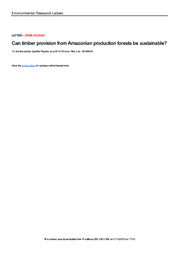Can timber provision from Amazonian production forests be sustainable?
Can timber provision from Amazonian production forests be sustainable?
Author(s): PIPONIOT, C.; RÖDIG, E.; PUTZ, F. E.; RUTISHAUSER, E.; SIST, P.; ASCARRUNZ, N.; BLANC, L.; DERROIRE, G.; DESCROIX, L.; GUEDES, M. C.; CORONADO, E. H.; HUTH, A.; KANASHIRO, M.; LICONA, J. C.; FREITAS, L. J. M. de; OLIVEIRA, M. V. N. d'; PEÑA-CLAROS, M.; RODNEY, K.; SHENKIN, A.; SOUZA, C. R. de; VIDAL, E.; WEST, T. A. P.; WORTEL, V.; HÉRAULT, B.
Summary: Around 30Mm3 of sawlogs are extracted annually by selective logging of natural production forests in Amazonia, Earth?s most extensive tropical forest. Decisions concerning the management of these production forests will be of major importance for Amazonian forests? fate. To date, no regional assessment of selective logging sustainability supports decision-making. Based on data from 3500 ha of forest inventory plots, our modelling results show that the average periodic harvests of 20m3 ha?1 will not recover by the end of a standard 30 year cutting cycle. Timber recovery within a cutting cycle is enhanced by commercial acceptance of more species and with the adoption of longer cutting cycles and lower logging intensities. Recovery rates are faster in Western Amazonia than on the Guiana Shield. Our simulations suggest that regardless of cutting cycle duration and logging intensities, selectively logged forests are unlikely to meet timber demands over the long term as timber stocks are predicted to steadily decline. There is thus an urgent need to develop an integrated forest resource management policy that combines active management of production forests with the restoration of degraded and secondary forests for timber production. Without better management, reduced timber harvests and continued timber production declines are unavoidable.
Publication year: 2019
Types of publication: Journal article
Unit: Embrapa Amapá
Keywords: Administração Florestal, Ecosystem recovery, Environmental impact, Exploración selectiva, Exploração Florestal, Explotación forestal, Extração da Madeira, Extração seletiva, Forest management, Impacto Ambiental, Logging, Lumber, Madeira Serrada, Manejo florestal, Modelo de Simulação, Modelos de simulación, Natural regeneration, Regeneración natural, Regeneração Natural, Selective logging, Simulation models, Tropical forestry
Observation
Some of Embrapa's publications are published as ePub files. To read them, use or download one of the following free software options to your computer or mobile device. Android: Google Play Books; IOS: iBooks; Windows and Linux: Calibre.
Access other publications
Access the Agricultural Research Database (BDPA) to consult Embrapa's full library collection and records.
Visit Embrapa Bookstore to purchase books and other publications sold by Embrapa.

